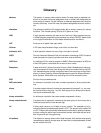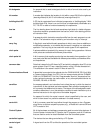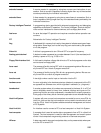539
Glossary
address The location in memory where data is stored. For data areas, an address con-
sists of a two-letter data area designation and a number that designates the
word and/or bit location. For the UM area, an address designates the instruction
location (UM area). In the FM area, the address designates the block location,
etc.
allocation The process by which the PC assigns certain bits or words in memory for various
functions. This includes pairing I/O bits to I/O points on Units.
AND A logic operation whereby the result is true if and only if both premises are true.
In ladder-diagram programming the premises are usually ON/OFF states of bits
or the logical combination of such states called execution conditions.
APF Acronym for all plastic fiber-optic cable.
AR area A PC data area allocated to flags, control bits, and work bits.
arithmetic shift A shift operation wherein the carry flag is included in the shift.
ASCII Short for American Standard Code for Information Interchange. ASCII is used to
code characters for output to printers and other external devices.
ASCII Unit An Intelligent I/O Unit used to program in BASIC. When connected to an NSU on
a Net Link System, commands can be sent to other nodes.
Backplane A base onto which Units are mounted to form a Rack. Backplanes provide a se-
ries of connectors for these Units along with wiring to connect them to the CPU
Unit. Backplanes also provide connectors used to connect them to other Back-
planes. In some Systems, different Backplanes are used for different Racks; in
other Systems, Racks differ only according to the Units mounted to them.
BCD Short for binary-coded decimal.
BCD calculation An arithmetic calculation that uses numbers expressed in binary-coded deci-
mal.
binary A number system where all numbers are expressed to the base 2, i.e., any num-
ber can be written using only 1’s or 2’s. Each group of four binary bits is equiva-
lent to one hexadecimal digit.
binary calculation An arithmetic calculation that uses numbers expressed in binary.
binary-coded decimal A system used to represent numbers so that each group of four binary bits is
numerically equivalent to one decimal digit.
bit A binary digit; hence a unit of data in binary notation. The smallest unit of in-
formation that can be electronically stored in a PC. The status of a bit is either ON
or OFF. Different bits at particular addresses are allocated to special purposes,
such as holding the status input from external devices, while other bits are avail-
able for general use in programming.
bit address The location in memory where a bit of data is stored. A bit address must specify
(sometimes by default) the data area and word that is being addressed, as well
as the number of the bit.


















